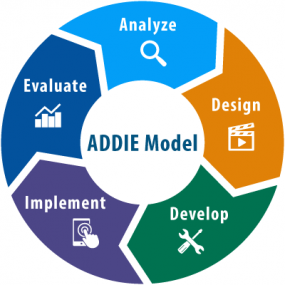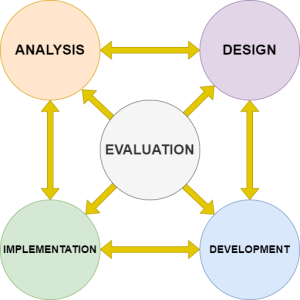ADDIE Model: Difference between revisions
From The Learning Engineer's Knowledgebase
m (1 revision imported) |
No edit summary |
||
| Line 38: | Line 38: | ||
Thus, revisions to the analysis, design, and development phases of a learning experience or educational product can be completed ''while'' a product is being [[Implementation (Phase of Design)|implemented]]! New ideas and changes to the product can also influence a product's implementation while it is happening. Essentially, every step in the web-like ADDIE model influences the other steps. In other words, you hop around the model to build your product! | Thus, revisions to the analysis, design, and development phases of a learning experience or educational product can be completed ''while'' a product is being [[Implementation (Phase of Design)|implemented]]! New ideas and changes to the product can also influence a product's implementation while it is happening. Essentially, every step in the web-like ADDIE model influences the other steps. In other words, you hop around the model to build your product! | ||
For many teams, projects often actually start at '''[[Evaluation | For many teams, projects often actually start at '''[[Evaluation and assessment|evaluation]]''', where they examine existing products to get ideas of what is out there already and see how similar situations have been handled by other designers. Reviewing existing products that are similar to the intended design at the start of a design project is a wonderful way of generating ideas and identifying the types of [[Interactions and activities|learning interactions]] that have been identified as being [[Evaluating learning and competency outcomes|effective to promote learning achievement]]. | ||
==Tips and Tricks== | ==Tips and Tricks== | ||
| Line 48: | Line 48: | ||
==Related Concepts== | ==Related Concepts== | ||
*[[ | *[[Models and frameworks]] | ||
*[[Analysis (Phase of Design)|Analysis phase of design]] | *[[Analysis (Phase of Design)|Analysis phase of design]] | ||
*[[Design (Phase of Design)|Design phase of design]] | *[[Design (Phase of Design)|Design phase of design]] | ||
*[[Development (Phase of Design)|Development phase of design]] | *[[Development (Phase of Design)|Development phase of design]] | ||
*[[Implementation (Phase of Design)|Implementation phase of design]] | *[[Implementation (Phase of Design)|Implementation phase of design]] | ||
*[[Evaluation | *[[Evaluation and assessment|Evaluation phase of design]] | ||
==Examples== | ==Examples== | ||
Latest revision as of 01:58, 11 February 2024
The ADDIE Model is a step-by-step process for making an educational experience or product. It is a common design approach in many industries, including educational design. It is an acronym for the following steps: Analyze - Design - Develop - Implement - Evaluate.
Definition
ADDIE is a model for how work can be completed on a design project. This model lays out each of the steps for the work as a sort of a blueprint for the tasks that a designer should consider and complete as they work on building an experience or product.
ADDIE has emerged as a common way for how design work gets done. It is a very common model used in design in basically every industry. ADDIE gives designers a step-by-step procedure for getting their work done.
Additional Information
Beginning an Educational Design Project with the ADDIE Model

In the ADDIE model, you conceptualize getting work done on the project by starting at the left of the model's workflow (i.e., the Analysis phase) and moving to the right, one step at a time. You typically start a project at the ANALYSIS phase, move to the DESIGN phase after you complete your analysis, and then start to DEVELOP the design's prototype, interfaces, and materials. After the idea has been developed, that is, it exists as something that can be used, it can be IMPLEMENTED in real-life settings. After implementation, the ADDIE model states that the implementation should be EVALUATED and see whether the experience or product met its intended goals that were established in the ANALYSIS phase.
There are five phases in the ADDIE model.
- Analysis. Tasks in this phase include identifying the need for the product and project goals, identifying learning objectives, determining the scope of the project, considering the intended audience and its needs, the key structural considerations of the design, and the constraints that could limit design.
- Design. This phase is where the ideas for everything that the participants will do, use, or interact with are defined. This includes defining and designing the interactions and activities that participants will do, technologies they will use, media they will use, and interfaces they will interact with.
- Development. This phase is where the design actually gets built or made from ideas.
- Implementation. This phase is when the design is actually used in real-world settings by participants.
- Evaluation. This phase is for identifying how the experience or product was used, what effect the experience had on participants' learning, and whether the design worked as intended.
⚠️ Beginner instructional designers should spend at least some time on each the analysis and design phases before moving on to development and actually building a learning experience or product!
It is indeed wise to start with the analysis phase of an educational design project by identifying the learning outcomes, defining the project scope by considering the structural and audience requirements, and by defining the constraints that affect your project. However, designers will likely return back to the analysis phase frequently as they discover new ideas, constraints, and challenges as they start to create the design specifications for their design and actually begin prototyping the design in the development phase.
Because designers always learn new things as they work along this path of steps, the ADDIE model is often criticized for being too linear or strict in the order of how designers should consider different aspects of the design. Many veteran designers will tell you that ADDIE is a useful framework to use when thinking about a new project, but that it rarely works as a linear, step-by-step process. Instead, designers will more realistically find themselves learning more about their project ideas and scope as they continue down the ADDIE flowchart once they start designing and developing. In a purely linear ADDIE model, when you reach the end of the ADDIE steps, your project is done and that it is time to say goodbye - which we know is not the case in practice.
Advanced Uses of the ADDIE Model
Many designers conceptualize their work as never being done: the previous version moves right into a new design cycle. This is often referred to as iterative design - when the designer takes a previous version and what they learned from evaluation to re-plan and revise the design to better achieve the intended goals. As a result, the ADDIE model can be viewed as more of a circular pattern of the steps that are taken toward project design.

However, many veteran designers have further criticized a circular model of ADDIE as being too restricting and not reflecting the "messy" reality of design. Design teams and stakeholders are often working together throughout the whole design process to identify new ideas, areas for project improvement, and fine-tuning how the design should look.
In response to this criticism of the ADDIE model being too restrictive, many veteran designers now commonly see the ADDIE model as a network or web of interconnected parts. In this networked view of the ADDIE model, each section is more of a stopping point to consider certain aspects of the project instead of a step-by-step process that must be followed in order. At first, you can begin following in the normal order of the ADDIE process, but you may also hop around the ADDIE steps as you build educational experiences and products. This "hopping around" is fine and normal to do!

Design teams find that they frequently hop around as they learn new things in the design and development phases that they couldn't anticipate during the initial analysis. Because of this, each of the phases are constantly being revised by the design team instead of only being thought about in their specific order as the original ADDIE model suggest. In this web or network version of the ADDIE steps, design teams may simultaneously change all of the parts when new things come to mind. This is common when the actual building and prototyping occurs and new limitations or challenges are discovered, forcing the teams to revise their initial plans to meet these constraints.
Evaluation is also central to the view of ADDIE as a web of parts. Successful teams are likely collecting and analyzing data at every step of the way to consider how the design will be used, how it gets used while implementation is occurring, and how designs can be improved after implementation. Evaluation is also often planned as early as possible to ensure that the proper instruments and analyses are selected and designed so that they can be used to answer the desired research questions about whether the design achieved its goals and was a "good" design. If you wait until the end of implementation to design your evaluations, you will likely find that you did not collect the right kind of data to answer whether the design met its goals!
Thus, revisions to the analysis, design, and development phases of a learning experience or educational product can be completed while a product is being implemented! New ideas and changes to the product can also influence a product's implementation while it is happening. Essentially, every step in the web-like ADDIE model influences the other steps. In other words, you hop around the model to build your product!
For many teams, projects often actually start at evaluation, where they examine existing products to get ideas of what is out there already and see how similar situations have been handled by other designers. Reviewing existing products that are similar to the intended design at the start of a design project is a wonderful way of generating ideas and identifying the types of learning interactions that have been identified as being effective to promote learning achievement.
Tips and Tricks
- It is ok to hop around the ADDIE model - you don't have to work on the steps in order! Review the "network-view" version of the model to visualize how each step is connected to the other steps.
- In addition to thinking about ADDIE as a linear process of the steps that you take to do your design work, you can also think of it as a map with checkpoints of the ground you should cover when you are making a learning experience. Each checkpoint has specific things that you should consider about your design. You can walk back and forth between the checkpoints. Some of these checkpoints, like DEVELOPMENT, needs some things at least to be answered in ANALYSIS and DESIGN before you can start actually building the design.
- You can both simultaneously see ADDIE as line, and as a web. It can be helpful, at least at the start of a project, to work on the project in the suggested order so that you at least initially consider the main points that go into a design. Once you start getting a substantive amount of design work done, you will likely need to hop around and revise each of these checkpoints.
Related Concepts
- Models and frameworks
- Analysis phase of design
- Design phase of design
- Development phase of design
- Implementation phase of design
- Evaluation phase of design
Examples
- None added yet - check back soon!
External Resources
- None added yet - check back soon!